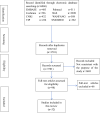Manual Therapy in Primary Dysmenorrhea: A Systematic Review and Meta-Analysis
- PMID: 38736680
- PMCID: PMC11088071
- DOI: 10.2147/JPR.S457381
Manual Therapy in Primary Dysmenorrhea: A Systematic Review and Meta-Analysis
Abstract
Objective: This research aimed to assess the effectiveness of manual therapy in alleviating pain among women undergoing primary dysmenorrhea (PD).
Methods: All randomized controlled trials (RCTs) regarding manual therapy for PD were searched from online databases, spanning from their inception to July 2023. The identified literature underwent a thorough screening process, and the data were meticulously extracted and analyzed using RevMan 5.3. Subsequently, the included studies underwent Cochrane's quality assessment and meta-analysis. The evidence obtained was then assessed using the grading of recommendations, assessment, development, and evaluation (GRADE) approach.
Results: 32 RCTs, involving 2566 women were finally included for analysis. The overall quality of the concluding evidence was generally rated as low or very low. Performance bias and blind bias were found to be the main risk of bias of the included studies. In comparison to no treatment, manual therapy demonstrated a significant increase in pain relief in short-term (n=191, MD=1.30, 95% CI: 0.24~2.37). The differences in the effects of manual therapy and the placebo on pain intensity may not be statistically significant (n=255, MD=0.10, 95% CI: -0.37~0.58). In contrast to NSAIDs, manual therapy exhibited superior pain alleviation (n=507, MD=3.01, 95% CI: 1.08~4.94) and a higher effective rate (n=1029, OR=4.87, 95% CI: 3.29~7.20). Importantly, no severe adverse events were reported across all studies, indicating a relatively safe profile for manual therapy.
Conclusion: Manual therapy presented promise in effectively relieving menstrual pain with minimal adverse events in short term, outperforming both no treatment and NSAIDs. However, this conclusion is tempered by the low quality of the included RCTs, highlighting the necessity for more robust trials to validate it.
Keywords: manual therapy; meta-analysis; primary dysmenorrhea; systematic review.
© 2024 Li et al.
Conflict of interest statement
The authors report no conflicts of interest in this work.
Figures













Similar articles
-
Chinese herbal formula siwutang for treating primary dysmenorrhea: A systematic review and meta-analysis of randomized controlled trials.Maturitas. 2020 Aug;138:26-35. doi: 10.1016/j.maturitas.2020.03.009. Epub 2020 May 13. Maturitas. 2020. PMID: 32631585
-
Exercise for dysmenorrhoea.Cochrane Database Syst Rev. 2019 Sep 20;9(9):CD004142. doi: 10.1002/14651858.CD004142.pub4. Cochrane Database Syst Rev. 2019. PMID: 31538328 Free PMC article.
-
Non-steroidal anti-inflammatory drugs for acute low back pain.Cochrane Database Syst Rev. 2020 Apr 16;4(4):CD013581. doi: 10.1002/14651858.CD013581. Cochrane Database Syst Rev. 2020. PMID: 32297973 Free PMC article.
-
Intra-articular viscosupplementation with hylan g-f 20 to treat osteoarthritis of the knee: an evidence-based analysis.Ont Health Technol Assess Ser. 2005;5(10):1-66. Epub 2005 Jun 1. Ont Health Technol Assess Ser. 2005. PMID: 23074461 Free PMC article.
-
Cochrane Review: Osmotic and stimulant laxatives for the management of childhood constipation (Review).Evid Based Child Health. 2013 Jan;8(1):57-109. doi: 10.1002/ebch.1893. Evid Based Child Health. 2013. PMID: 23878124 Review.
Cited by
-
An Examination into the Safety and Efficacy of Khapregesic®, a Khaya Senegalensis Preparation, on Women Experiencing Menstrual Pain and Menstrual Distress: A Randomized, Double-Blind, Placebo-Controlled Trial.Int J Womens Health. 2025 Jul 12;17:2025-2038. doi: 10.2147/IJWH.S521349. eCollection 2025. Int J Womens Health. 2025. PMID: 40672875 Free PMC article. Clinical Trial.
References
Publication types
LinkOut - more resources
Full Text Sources

